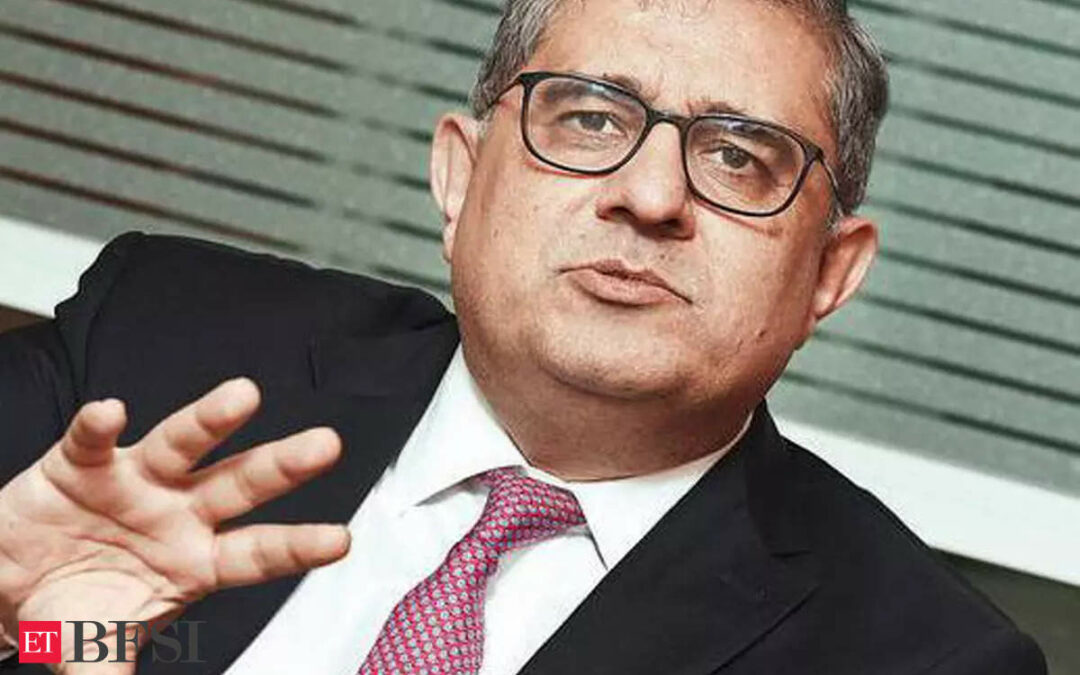Axis Bank may have cleaned up its bad loans and reoriented the business, but it has a long way to go in terms of market share and dominance in various segments, says chief executive Amitabh Chaudhry. The Reserve Bank of India would only tighten and not loosen regulations given the threats from technology and weak lending practices, Chaudhry tells ET. Edited excerpts:
Interest rates are debated widely and even two members of the Monetary Policy Committee are voting for a cut. How do you see this?
I think the pause will continue for some time. The RBI has actually floated a balloon looking at an 8% GDP growth rate. They believe that if 8% GDP growth can be delivered, they would like to attack inflation and get it down to 4%. And if that is the case, then why will they cut rates? So, I don’t see any reason why cutting rates would happen in a hurry. And once you’re down the path of cutting rates, you don’t want to kind of go back up. So, you have to be sure that when you start cutting rates, it’s headed in that direction. We don’t expect any rate cut this year.
The RBI is worried about the retail segment. Is there a bubble?
We are not seeing signs (of bubbles) in our portfolio. But yes, we have to be extremely watchful. In case of loans, which are given digitally end to end, you’re seeing that when people start delaying the payments, they tend to fall off quickly and once they fall off, the recovery is quite low. So, you’re seeing that difference on the digital side. In Covid, we went through two short but sharp cycles, and so the system did get tested. Unlike the wholesale side, in retail loans, the money is coming every month, and there is a lot of customer data from CIBIL and its likes. So, assuming you did not lend well in six months, you will see high default rates.What if the economy slows and high interest rates begin to bite?
Let’s say the Indian economy were to slow down, there would be a largescale impact on the consumers, who generally had the right intent to pay and had the means to pay but are now suffering. But given the economic growth being talked about, I think that is a lesser probability. So, the higher probability is that some customers are overreaching themselves; they’re either using the money for personal consumption or investing in the stock market or gaming apps. They are potentially a problem. So, you might do bad lending for a certain period, but when you catch it very quickly, you correct yourself. And the banks are at the lower end of the risk curve anyway.The Axis Bank stock has outperformed peers, has market recognised positive changes brought about by you?
Notwithstanding the recent run in the stock price, we’re trying to create a sustainable, credible franchise that should stand the test of time. SBI and two other banks are much bigger than us in terms of market cap and size, but the market does realise that we are a large institution in the making. But, given our size compared to others, we still have some distance to cover. And we know what some of those levers would be.
What are those levers?
Our products can be better than some of our peers; our NIM (net interest margin) compared to ICICI Bank is still slightly lower, and cost of deposits is higher. So, there are areas that we need to work on. There are businesses where we might be ranked third or fourth; we should have many more businesses ranked as one or two rather than three and four.
Your market share is 5% in deposits and 5.9% in advances. What’s your goal?
I cannot give any guidance. But obviously, we’re not happy. The franchise can do much more. So, if we can get all these pieces to work well together, automatically, it will start growing at a much faster pace than the industry, and it will finally reflect in the market.
There’s a common complaint against deposit mobilisation. How do you address it?
We also know that given the fight against inflation, they will keep tight control of the liquidity in the system. So, our view is deposit growth (for Axis) will not be more than 13%. And so, given the credit growth in that environment, we have to transform. There is no choice. But we have to do it at the right pace because if we do it too fast, we could fail.
The regulator is being seen as aggressive when it comes to penalising non-compliance. How do you read it?
They use a combination of actions. It’s not just stopping business. It appears that RBI’s action could or would have happened only after they came to a conclusion over a decent period of time that maybe they’re not seeing the level of progress they expect to see. I think we must become better at reading what the regulator is thinking. Because regulator will invariably never spell out that if you don’t do this; this will happen to you.
Is the industry a bit lax in compliance?
We must comply more with the spirit of regulations than just the guidelines. And when the regulator tells us that this is a problem, we need to react much faster than we did in the past. And if they’re saying this is not allowed, we should stop it immediately. Now, they’re getting increasingly worried about technology because the systems are so interconnected that if one large part of the system goes down, it creates a problem across the system.
Is technology the single most important factor in compliance?
I think all of us are investing heavily in that (technology) area. The RBI also does much more frequent audits of the technology architecture of banks than in the past. But sometimes it also gets triggered by our expectations around DR (disaster recovery), which has to work. If a bank says it has invested in technology but if the drill did not work, the RBI will get worried with that DR model. Tomorrow, the same problem may happen with your system; you will not be able to get going within a defined period, which will again impact the system. So, my view is that the RBI is reacting to incidents much more quickly and decisively than ever before.
So cyber security is a bigger worry…
It’s a huge worry. We have a large financial crimes intelligence team, and we have come up with some 50 to 60 things to implement, but it’s almost like trying to keep pace with what is happening. It’s like assuming a tiger is after you, and you have to be much faster. Quite a few people are running because the tiger is running after them. These people (fraudsters) are doing that 24×7, so hopefully, they’ll go after people who are much more vulnerable than we are.










